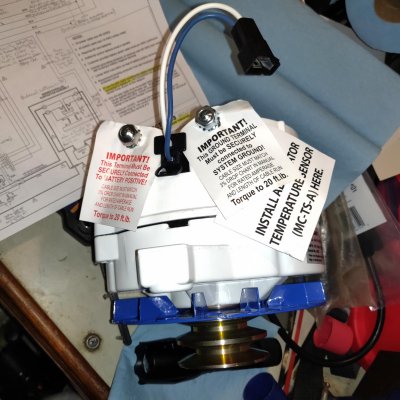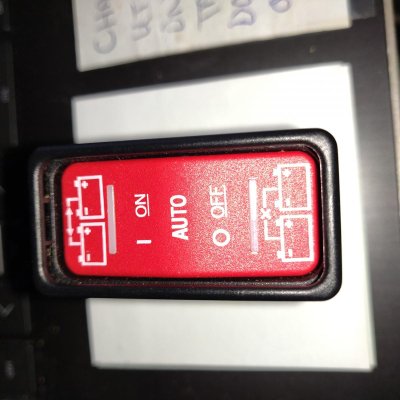Wil
Senior Member
- Joined
- Jul 8, 2013
- Messages
- 187
- Location
- US
- Vessel Name
- Gone Walkabout
- Vessel Make
- 1999 KadeyKrogen 39
In this wiring diagram, all of it, except the House Bank and its positive and negative busses, is Starting Bank wiring. The basic concept is to have a dedicated charge circuit for my 200A isolated ground alternator feeding the 900Ah House Bank using 4/0 cable for both positive and negative sides (with no battery switches in between). Then a cross-feed from House to Start Bank again using 4/0 cable for positive and negative sides, with a Blue Sea 500A Automatic Charge Relay (ACR) to connect the positive x-feed when charging voltage is present. The ACR has three separate operational states via a remote switch: Connected, Disconnected, or Auto (used for sensing charge voltage to auto-connect House to Start bank). There is also a manual switch on the unit itself.
By substituting a 500A Off/Both/1/2 battery switch for the simple #1 Start Battery On/Off switch (as was originally intended), one gains the ability to use either the House (position 1) or Start Bank (position 2) as the power source for the Start Bank loads, or combine (position Both) the banks when using the ACR to charge the Start Bank. The switch can be left on Both all the time when the ACR is in Auto mode—the banks will only combine when charging voltage is present. Another example, to use the House Bank only for the Start loads, put the switch on position 1. Position 2 for just the Start Bank to Start loads.
The Start/House Bank's negative busses combine at the engine block (e.g., starter housing mounting bolt) with 4/0 cable.
The 200A alternator should have dedicated positive and negative 4/0 cables.
The cross-feed is 4/0 cable to support Start loads when using House Bank.
The 'S-P Contactor' is the series-parallel contactor that puts the two Start batteries in series or parallel configuration for either bow thruster operation or charging both batteries at 12v, respectively.
Question: If the House & Start Bank negative busses are tied together at the engine block (e.g., starter housing mounting bolt) with 4/0 cable, can I just run a 4/0 cable from the alternator isolated ground to the same starter housing mounting bolt(s)? Ground loops?
Question: Does the wiring diagram look functional? Constructive criticism welcome...
By substituting a 500A Off/Both/1/2 battery switch for the simple #1 Start Battery On/Off switch (as was originally intended), one gains the ability to use either the House (position 1) or Start Bank (position 2) as the power source for the Start Bank loads, or combine (position Both) the banks when using the ACR to charge the Start Bank. The switch can be left on Both all the time when the ACR is in Auto mode—the banks will only combine when charging voltage is present. Another example, to use the House Bank only for the Start loads, put the switch on position 1. Position 2 for just the Start Bank to Start loads.
The Start/House Bank's negative busses combine at the engine block (e.g., starter housing mounting bolt) with 4/0 cable.
The 200A alternator should have dedicated positive and negative 4/0 cables.
The cross-feed is 4/0 cable to support Start loads when using House Bank.
The 'S-P Contactor' is the series-parallel contactor that puts the two Start batteries in series or parallel configuration for either bow thruster operation or charging both batteries at 12v, respectively.
Question: If the House & Start Bank negative busses are tied together at the engine block (e.g., starter housing mounting bolt) with 4/0 cable, can I just run a 4/0 cable from the alternator isolated ground to the same starter housing mounting bolt(s)? Ground loops?
Question: Does the wiring diagram look functional? Constructive criticism welcome...
Attachments
Last edited by a moderator:



 !
!